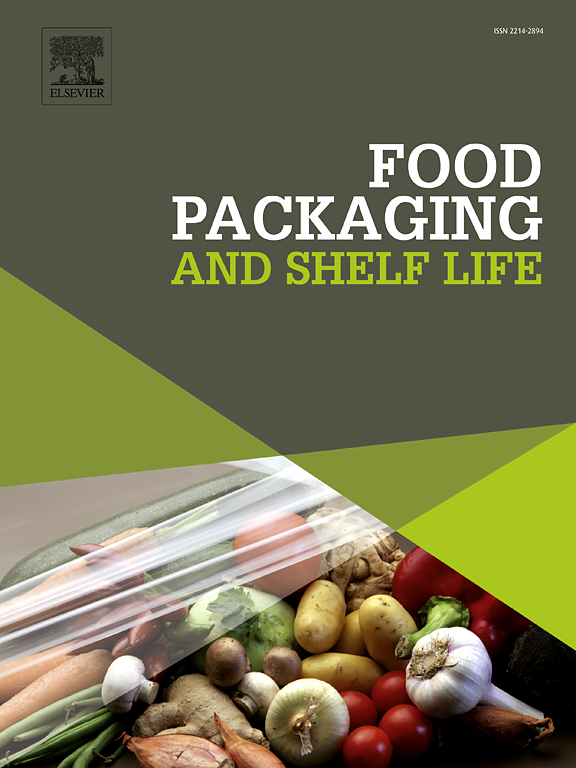Effect of transglutaminase concentration on the properties of soy protein isolate-pectin composite edible films
IF 8.5
1区 农林科学
Q1 FOOD SCIENCE & TECHNOLOGY
引用次数: 0
Abstract
Enzymes such as transglutaminase (TGase) have been used to catalyze protein cross-linking reactions to enhance protein properties. The present study investigates the effects of TGase treatment and concentration on the properties of soy protein isolate (SPI)-pectin films. SPI-pectin films were prepared by adding 0.5 %, 1 %, and 1.5 % TGase. The film with no added enzyme served as a Control. Film thickness, water activity (aw), and antioxidant activity slightly increased (P < 0.05). Film opacity increased (P < 0.05) with the addition of TGase. Transparency significantly (P < 0.05) reduced at 1.5 % TGase concentration. The water vapor permeability (WVP) of the films declined after being enzyme-treated. Besides, increased TGase concentration affected mechanical properties; films with the highest TGase concentration, i.e., 1.5 %, were least (P < 0.05) stiff and had the lowest Young's Modulus and tensile strength. However, this film had the highest % elongation. 1 % TGase film was the toughest to break, recording the highest total area (5758 g.sec) followed by the Control (5628 g.sec). TGase cross-linked films possessed higher (P < 0.05) water holding capacity (WHC) than that of Control films. As investigated through Scanning Electron Microscopy (SEM), TGase-treated films revealed different degrees of protein cross-linking as a function of enzyme concentration. However, the 1 % enzyme concentration led to a compact film structure with no microfractures. Overall, TGase treatment can be a practical approach to enhancing protein-based film properties.
转谷氨酰胺酶浓度对大豆分离蛋白-果胶复合食用膜性能的影响
谷氨酰胺转酶(TGase)等酶已被用于催化蛋白质交联反应,以提高蛋白质的性能。研究了TGase处理和浓度对大豆分离蛋白(SPI)-果胶薄膜性能的影响。分别添加0.5 %、1 %和1.5 %的TGase制备了spi -果胶薄膜。不添加酶的薄膜作为对照。膜厚、水活度(aw)和抗氧化活性略有增加(P <; 0.05)。随着TGase的加入,膜透明度增加(P <; 0.05)。当TGase浓度为1.5 %时,透明度显著降低(P <; 0.05)。经酶处理后,膜的水蒸气渗透性(WVP)下降。此外,TGase浓度的增加对力学性能也有影响;当TGase浓度为1.5 %时,薄膜的硬度最低(P <; 0.05),杨氏模量和拉伸强度最低。而该薄膜的伸长率最高。1 % TGase薄膜最难破,面积最大(5758 g.sec),其次是Control(5628 g.sec)。TGase交联膜的持水量(WHC)高于对照膜(P <; 0.05)。通过扫描电镜(SEM)研究,tgase处理的膜显示出不同程度的蛋白质交联,这是酶浓度的函数。然而,1 %的酶浓度导致致密的膜结构,没有微断裂。总的来说,TGase处理可以是一种实用的方法来提高基于蛋白质的薄膜性能。
本文章由计算机程序翻译,如有差异,请以英文原文为准。
求助全文
约1分钟内获得全文
求助全文
来源期刊

Food Packaging and Shelf Life
Agricultural and Biological Sciences-Food Science
CiteScore
14.00
自引率
8.80%
发文量
214
审稿时长
70 days
期刊介绍:
Food packaging is crucial for preserving food integrity throughout the distribution chain. It safeguards against contamination by physical, chemical, and biological agents, ensuring the safety and quality of processed foods. The evolution of novel food packaging, including modified atmosphere and active packaging, has extended shelf life, enhancing convenience for consumers. Shelf life, the duration a perishable item remains suitable for sale, use, or consumption, is intricately linked with food packaging, emphasizing its role in maintaining product quality and safety.
 求助内容:
求助内容: 应助结果提醒方式:
应助结果提醒方式:


